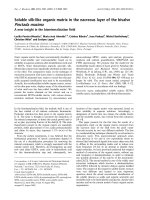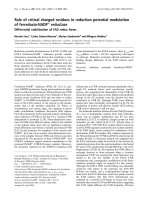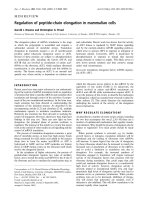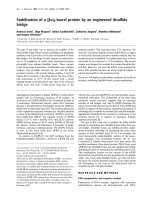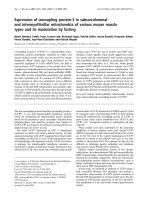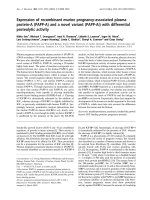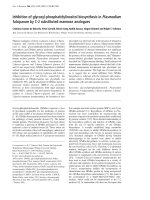Bóa cáo y học: "Economics of immunization information systems in the United States: assessing costs and efficiency" potx
Bạn đang xem bản rút gọn của tài liệu. Xem và tải ngay bản đầy đủ của tài liệu tại đây (308.83 KB, 10 trang )
BioMed Central
Page 1 of 10
(page number not for citation purposes)
Cost Effectiveness and Resource
Allocation
Open Access
Research
Economics of immunization information systems in the United
States: assessing costs and efficiency
Diana L Bartlett*
1
, Noelle-Angelique M Molinari
1
, Ismael R Ortega-Sanchez
2
and Gary A Urquhart
1
Address:
1
Immunization Services Division, National Center for Immunization and Respiratory Diseases, Centers for Disease Control and
Prevention, 1600 Clifton Rd., NE, MS-E62 Atlanta, GA, 30333, USA and
2
Viral Diseases Division, National Center for Immunization and
Respiratory Diseases, Centers for Disease Control and Prevention, 1600 Clifton Rd., NE, MS-A47, Atlanta, GA, 30333, USA
Email: Diana L Bartlett* - ; Noelle-Angelique M Molinari - ; Ismael R Ortega-
Sanchez - ; Gary A Urquhart -
* Corresponding author
Abstract
Background: One of the United States' national health objectives for 2010 is that 95% of children aged
<6 years participate in fully operational population-based immunization information systems (IIS). Despite
important progress, child participation in most IIS has increased slowly, in part due to limited economic
knowledge about IIS operations. Should IIS need further improvement, characterizing costs and identifying
factors that affect IIS efficiency become crucial.
Methods: Data were collected from a national sampling frame of the 56 states/cities that received federal
immunization grants under U.S. Public Health Service Act 317b and completed the federal 1999
Immunization Registry Annual Report. The sampling frame was stratified by IIS functional status, children's
enrollment in the IIS, and whether the IIS had been developed as an independent system or was integrated
into a larger system. These sites self-reported IIS developmental and operational program costs for
calendar years 1998–2002 using a standardized data collection tool and underwent on-site interviews to
verify reported data with information from the state/city financial management system and other financial
records. A parametric cost-per-patient-record (CPR) model was estimated. The model assessed the
impact of labor and non-labor resources used in development and operations tasks, as well as the impact
of information technology, local providers' participation and compliance with federal IIS performance
standards (e.g., ensuring the confidentiality and security of information, ensure timely vaccination data at
the time of patient encounter, and produce official immunization records). Given the number of records
minimizing CPR, the additional amount of resources needed to meet national health goals for the year
2010 was also calculated.
Results: Estimated CPR was as high as $10.30 and as low as $0.09 in operating IIS. About 20% of IIS had
between 2.9 to 3.2 million records and showed CPR estimates of $0.09. Overall, CPR was highly sensitive
to local providers' participation. To achieve the 2010 goals, additional aggregated costs were estimated to
be $75.6 million nationwide.
Conclusion: Efficiently increasing the number of records in IIS would require additional resources and
careful consideration of various strategies to minimize CPR, such as boosting providers' participation.
Published: 22 August 2006
Cost Effectiveness and Resource Allocation 2006, 4:15 doi:10.1186/1478-7547-4-15
Received: 30 January 2006
Accepted: 22 August 2006
This article is available from: />© 2006 Bartlett et al; licensee BioMed Central Ltd.
This is an Open Access article distributed under the terms of the Creative Commons Attribution License ( />),
which permits unrestricted use, distribution, and reproduction in any medium, provided the original work is properly cited.
Cost Effectiveness and Resource Allocation 2006, 4:15 />Page 2 of 10
(page number not for citation purposes)
Background
One United States national health objective for 2010 is to
have at least 95% of U.S. children aged <6 years partici-
pate in fully operational population-based immunization
registries or immunization information systems (IIS) [1].
To achieve this objective the Centers for Disease Control
and Prevention (CDC), through its National Immuniza-
tion Program (NIP) awarded $262 million in immuniza-
tion grants from 1994 to 2002 to develop and operate IIS
in the 50 states, the District of Columbia, five urban areas,
and all U.S. territories (CDC/Kim Lane, unpublished data,
2003). During this time period, the National Vaccine
Advisory Committee recommended that the CDC deter-
mine the resources needed to further develop and main-
tain these systems as part of the requirements to ensure
sustainable IIS funding [2].
As of 2002, approximately 43% of children of U.S. chil-
dren <6 years of age had two or more vaccinations
recorded in an IIS [3]. Although important progress has
been made in populating these systems with vaccination
records, achieving the 2010 IIS objective would not only
require additional resources or funds but also a better
understanding of how these resources can effectively be
allocated to each IIS. Therefore, characterizing IIS devel-
opment and operational costs as well as identifying other
factors that affect IIS efficiency could assist public health
agencies in planning, strengthening and further develop-
ing these systems.
Using a nationally representative sample of IIS, this article
evaluates economic determinants of IIS performance by
estimating the influence of development and manage-
ment costs of in-house and contracted labor and non-
labor and resources used by IIS centralized systems. It also
measures the effect of standards and other factors affecting
the functioning of such systems, determines the threshold
of patient records needed to minimize average cost per
patient record (CPR), and identifies strategies to increase
efficiency.
Methods
Sample and setting
Data were collected from a national sampling frame of the
56 states/cities that received federal immunization grants
under Public Health Service Act §317b and completed the
CDC/NIP 1999 Immunization Registry Annual Report – a
self-administered questionnaire applied to immunization
program managers. This questionnaire assessed the per-
centage of children <6 years of age with >2 immunizations
enrolled in an IIS, the percentage of provider sites partici-
pating in the IIS, whether the IIS operated independently
or integrated with other health information systems, and
evaluated the functional status of the IIS according to 12
federal IIS performance standards (e.g., ensuring the con-
fidentiality and security of information, ensure timely vac-
cination data at the time of patient encounter, produce
official immunization records) defined in more detail
elsewhere [3].
Table 1 describes the IIS in the sampling frame. The sam-
pling frame used the measures derived from the 1999
annual report to stratify IIS by how well they functioned
(a score based on the number of federal IIS functional
standards achieved), the percentage of children <6 years
of age enrolled in the IIS, and whether the IIS had been
developed as an independent system or was integrated
into a larger public health system.
IIS were classified as 'low', 'medium', or 'high' in terms of
children enrolled if the percentage of children enrolled
was < 1.7%, >1.7% and < 53.5%, or > 53.5%. IIS were
classified as 'low', 'medium', or 'high' in terms of IIS func-
tionality score if the percentage of IIS functional standards
achieved was < 37.1%, >37.1% and < 69.9%, or > 69.9%.
These cut points were chosen to represent natural breaks
in the data. Two IIS were randomly sampled from each
stratum or all IIS sampled if ≤ 2 in a stratum with the
exception of high functional score and low child enroll-
ment where 3 were sampled because 2 states shared the
same IIS. 17 IIS were under development and fell into a
stratum of <37.1% functional score and <1.7% child
enrollment; 4 IIS were randomly sampled from this group
for participation in this study. The final sample consisted
of 24 IIS. These IIS varied by duration of operation (about
half began IIS development in 1993) and targeted age
range (most IIS collected vaccination data on persons
aged 0–18 years old).
Data collection
In August 1999, the IIS sites in the sample collected devel-
opmental and operational program costs for calendar
years 1998 and 1999. From May to October 2003,
researchers visited the selected sites with on-site inter-
views to collect IIS expenditures for calendar years 2000–
2002 and verify data collected previously. Since the 1999
assessment, many IIS had upgraded to web-based systems,
expanded their partnerships and marketing efforts to the
private sector, and found additional funding sources.
These data were combined with data from CY 1998–1999
to allow analysis over a five year period. All sites reported
data from their financial management offices and internal
records.
Annual expenditures were collected as line items for in-
house personnel (including fringe benefits), contractor
full-time equivalents (FTEs), equipment, supplies, travel,
contractual expenses, other expenses, and indirect costs.
Object class definitions developed by the Office of Man-
Cost Effectiveness and Resource Allocation 2006, 4:15 />Page 3 of 10
(page number not for citation purposes)
agement and Budget (OMB) for Federal program costs
were used to categorize expenditures [4].
Data on IIS expenditures by source of funds were also col-
lected. These included federal immunization grants under
Public Health Service Act §317b; 'other' federal sources
such as other CDC funds, Maternal and Child Health
block grants, Vaccines for Children program funds, or
funds from the Centers for Medicare and Medicaid Serv-
ices; state and local government funds; private sector
funds; in-kind contributions; and funds from other
sources, such as fees from IIS subscribers. Personnel and
contractual cost line items included costs to develop and
operate the IIS, to enter data at the central IIS, to evaluate
the IIS, and for marketing efforts to recruit parents and
health providers to participate in the IIS. Only costs to
operate the central IIS within a geographic area were
included (i.e., costs for daily operations of local IIS within
a state were excluded). IIS costs to providers were
excluded. For IIS that were a part of a larger, integrated
information system (i.e., system includes lead and meta-
bolic screening data), only the central IIS system's portion
of these costs were collected, not the costs to develop and
operate the entire integrated system.
All IIS line item costs were separated into developmental
and operational costs. Developmental costs were defined
as costs incurred prior to any immunization data submis-
sion, storage, or access by an immunization provider.
Software and hardware upgrade costs were also consid-
ered developmental costs, especially in regard to upgrad-
ing to a web-based system. Operational costs were defined
as costs to maintain the current status of the IIS after
immunization providers began to submit data or access
IIS records.
Economic analysis
Annual mean IIS costs were estimated for labor, non-
labor, development and operations by funding source and
by number of patient records (all ages) in the IIS. Labor
costs included personnel salaries and fringe benefits of
persons who were city/state government employees as
well as contractor full-time equivalents (FTEs) who
worked as IIS employees. All other costs, including indi-
rect costs, were included in non-labor costs. Cost data
from 1998–2001 were adjusted to 2002 dollars using the
Consumer Price Index [5]. Descriptive statistics were
weighted to be nationally representative and analyzed
using NLOGIT econometric software version 3.0.2.
To examine factors that influenced average CPR in IIS and
estimate prospective costs of achieving the Healthy People
2010 goals, a behavioral cost equation was estimated
using weighted least squares with site-specific fixed effects.
By allowing for site-specific heterogeneity, one could cap-
ture the effect on CPR of any unobserved site-specific
Table 1: Number of immunization information systems (IIS) stratified* by child enrollment and IIS functional score
Score of achievement of IIS functional standards
†
<37.1% ≥37.1% & <69.9% 69.9% +
Low
§
Medium High
IIS integrated within larger system
Children <6 years of age enrolled
<1.7% Low Unknown 0 4 (3)
≥1.7% & <53.5% Medium 0 5 (2) 5 (2)
53.5% + High 0 7 (2) 1 (1)
IIS operating as independent system
Children <6 years of age enrolled
<1.7% Low Unknown 0 2 (2)
≥1.7% & <53.5% Medium 0 4 (2) 4 (2)
53.5% + High 0 4 (2) 3 (2)
17 (4) 20 (8) 19 (12)
* Two IIS were randomly sampled from each stratum or all IIS sampled if ≤ 2 in a stratum with the exception of high functional score and low child
enrollment where 3 were sampled because 2 states shared the same IIS. Number sampled is in parentheses. Cut points in the strata were chosen to
represent natural breaks in the data.
†
Indicates an IIS minimum functional standard recommended by the National Center for Immunization and Respiratory Diseases (NCIRD)
Technical Working Group. />.
§
17 IIS were under development and fell into a stratum of <37.1% functional score and <1.7% child enrollment; 4 IIS were randomly sampled from
this group for participation in this study.
Cost Effectiveness and Resource Allocation 2006, 4:15 />Page 4 of 10
(page number not for citation purposes)
characteristics. This greatly improved the precision of esti-
mates. The equation for the CPR of site i's IIS in period t
was represented by:
where AC
it
is average cost for site i in period t,
α
i
is the site-
specific fixed effect for site i, w
it
is the wage of labor, rk
it
is
expenditures on capital, Q
it
is total patient records in IIS,
ξ
it
is achievement of IIS functional standards, and the X
it
are site characteristics. The regression error for site i in
period t is e
it
. Each of the 24 sampled IIS were observed
once per year for a period of five years. Therefore, the sam-
ple consisted of 120 data entries. In the final sample, each
entry referred to the observation of a specific IIS in a given
year, henceforth an IIS-year.
Average CPR was transformed by the natural log as were
wages and expenditures to better approximate their rela-
tionship to average cost, which was log-normally distrib-
uted. In order to allow for the presumed U-shape of the
average cost curve, output was specified in quadratic form.
This fixed effects model was estimated using weighted
least squares to account for stratified sampling with
robust estimation of the covariance matrix. Standard
errors were corrected using the finite population correc-
tion factor, since sample size approached population size,
n → N.
The cost of achieving the Healthy People 2010 goal for
each sampled IIS was calculated using parameters
retrieved from the average cost estimation, discounting at
a rate of 3%. For simplicity, it was assumed that each IIS
met all 12 functional standards (the Healthy People 2010
IIS goal includes having 95% child participation in an IIS
that is fully functional, i.e., meets the 12 IIS functional
standards) while other variables were evaluated at their
2002 values. It was assumed, again for simplicity, that the
gap between current child participation and 95% child
participation was closed at a linear rate of one-eighth the
gap per year, while the IIS continued to maintain the aver-
age child population growth rate that it had exhibited in
the previous five years. IIS that had already achieved or
exceeded 95% child participation were assumed to con-
tinue to maintain current participation levels by growing
with the child population.
In order to illustrate the importance of vaccine provider
participation in an IIS, the impact of simultaneously
achieving 95% child participation and 95% provider site
participation was also examined. The same assumptions
used previously were employed. In addition to child par-
ticipation, the gap between current provider site participa-
tion and 95% provider site participation would close at a
linear rate of one-eighth the gap per year. Sampled IIS
totals were weighted and the national cost for all 56 IIS to
achieve the Healthy People 2010 goal was calculated with
and without 95% provider site participation.
Results
Table 2 presents summary statistics for estimated annual
labor, non-labor, and total costs by category of spending,
development or operations, and IIS size in terms of
patient records in the IIS database. The estimated mean
annual immunization IIS total cost ranged from $919,421
for IIS with 860,000 patient records or less to $1,487,324
for IIS with over 3.4 million patient records. Estimated
mean annual labor costs increased as patient records in an
IIS increased from $359,381 for IIS with <860,000 patient
records to $1.1 million for IIS with the most patient
records. Estimated mean annual non-labor costs were a
larger proportion of estimated mean annual total costs for
IIS with <3.4 million patient records. Estimated mean
annual development costs were greatest for IIS with
<860,000 patient records while IIS with 1.7 million-3.4
million patient records had the highest estimated mean
annual operations costs.
Figure 1 presents the distribution of funds by source and
IIS size. In general, CDC immunization grants and state
funds accounted for the majority of funding and increased
with size of IIS. For IIS with less than 860,000 records,
64% of funds came from federal sources; 51% from CDC
immunization grants and 13% from other federal sources.
State funds accounted for 21% of the total. For IIS with
between 860,000 and 1.72 million records, federal funds
accounted for 64% of total funds with 59% from CDC
317 immunization grants. State governments contributed
29% of total funds. IIS with patient records between 1.72
and 2.85 million experienced a somewhat different mix of
funding sources. Federal funds accounted for 31% of the
total with CDC immunization grants representing 29%
and other federal funds comprising 2%. State funding
contributed 42% of the total. IIS with 2.85 to 3.44 million
records received 47% of total funds from federal sources
with 33% from CDC immunization grants. These IIS
received 26% and 3% of funds from state and local gov-
ernments respectively. IIS with more than 3.44 million
records received 95% of funds from CDC immunization
grants. The remaining 5% was composed of 4% in-kind
contributions and 1% state government contributions.
Table 3 presents results from the fixed effects, weighted
least squares estimation of the average cost function for
sites with patient records > 0. Site-specific effects were
strongly significant, indicating that unique characteristics
of each project site did influence CPR. Table 3 presents
statistically significant coefficients and the impact of asso-
ciated variables on average cost. The model did not
directly compare integrated with independent IIS in the
ln( ) ln lnAC w rk Q Q X e
it i it w it k it Q it Q it X it i
=+ + + + + + +
αβξ β β β β β
ξ
12
2
tt
a
()
Cost Effectiveness and Resource Allocation 2006, 4:15 />Page 5 of 10
(page number not for citation purposes)
regression due to collinearity. The impact of independent
variables on average costs are displayed as marginal effects
or elasticities impacts in the table. Marginal effects are dis-
played for categorical variables indicating the impact of
the IIS having the associated characteristic in a given year.
Elasticities, which are sensitivity measures of change, are
estimated for continuous variables used in the regression.
Specifically, other things remaining equal, the elasticity
measures the proportional or relative response of average
cost given a one percent increase in a specific independent
variable (e.g., personnel wages or government funds).
Funding sources affected average costs although receipt of
CDC immunization grant funds did not significantly
affect average costs. Receipt of other federal, local, and in-
kind funds tended to be associated with increased average
costs. Specifically, receipt of local government funds and
in-kind contributions was associated with an increased
CPR by $1.05 and $0.78 respectively while receipt of
other Federal funds was associated with an increased CPR
by $0.39. Conversely, receipt of state or private funds was
associated with a reduced CPR by $0.41 and $0.24 respec-
tively. Funds from other sources did not significantly
affect average costs.
Achievement of the 12 IIS functional standards also
impacted the average CPR, though certain standards
impacted more than others. Specifically, ensuring data
Table 2: Estimated annual immunization information system (IIS) costs
†
by category of spending and IIS size
§
IIS size in thousands of patient records
0 to 860 860 to 1,720 1,720 to 2,580 2,580 to 3,440 Over 3,440
IIS years* N 79 12 17 10 2
% 66 10 14 8 2
Total Population Mean 3,606,105 7,494,123 5,960,495 10,533,124 21,538,762
(StDev) (3,150,708) (2,363,222) (4,422,892) (5,424,221) (280,246)
Child Population Mean 298,844 654,015 507,237 911,436 2,074,273
(StDev) (260,203) (178,398) (429,933) (564,371) (49,338)
Child Participation Mean 29% 63% 72% 59% 44%
(StDev) (0.54) (0.43) (0.29) (0.26) (0.14)
Non Labor Cost
Development Mean 285,509 142,031 163,740 291,374 0
(StDev) (578,487) (286,985) (337,863) (481,137) 0
Operations Mean 274,531 696,142 596,064 679,860 454,966
(StDev) (769,412) (541,044) (923,378) (1,029,998) (124,004)
Total Non labor Mean 560,040 838,174 759,804 971,233 366,191
(StDev) (1,039,098) (629,139) (1,098,955) (1,192,329) (301,553)
Labor Costs
Development Mean 248,554 100,941 63,814 131,161 102,039
(StDev) (623,388) (159,685) (135,881) (370,508) (204,079)
Operations Mean 110,827 419,317 554,676 480,370 1,019,093
(StDev) (219,691) (559,807) (337,150) (534,342) (618,350)
Total Labor Mean 359,381 520,258 618,490 611,531 1,121,132
(StDev) (600,991) (489,775) (304,919) (601,790) (414,271)
Overall Costs
Development Mean 534,063 242,972 227,554 422,534 102,039
(StDev) (813,133) (394,978) (379,468) (700,865) (204,079)
Operations Mean 385,358 1,115,459 1,150,740 1,160,230 1,019,093
(StDev) (850,668) (914,221) (1,091,372) (1,234,443) (618,350)
Total Mean 919,421 1,358,431 1,378,294 1,582,764 1,487,324
(StDev) (1,121,652) (900,971) (1,237,504) (1,592,114) (715,824)
*IIS years connotes an observation for each of the 24 sampled IIS once per year over a five year period; therefore the sample for our analysis
consisted of 120 data entries. Each entry refers to the particular observation of a specific IIS in a given year, henceforth an IIS-year
†
Dollars per IIS year inflated to 2002 dollars
§
Cut points are based on 5 equal intervals between 0 and 3.6 million patient records
Cost Effectiveness and Resource Allocation 2006, 4:15 />Page 6 of 10
(page number not for citation purposes)
accuracy and completeness increased average cost by
$0.51 per record while IIS ability to receive and process
vaccination data within one month of vaccine administra-
tion increased CPR by $0.41. These were followed in
impact by the ability for a clinic to access IIS data during
patient visits (-$0.31) and the ability to create an IIS
record within six weeks of birth ($0.22). Average costs for
IIS that met all 12 functional standards increased by $0.21
per record compared to IIS that did not meet all standards.
IIS ability to identify persons needing vaccine reminder/
recall notifications decreased the CPR by $0.16, and the
ability to automatically produce immunization coverage
reports and official immunization records decreased aver-
age costs by $0.11 and $0.17 respectively.
Population characteristics and demographics are usually
important determinants of average cost. While popula-
tion density did not significantly influence CPR, as the
proportion of IIS patient records belonging to children
increased, average costs declined. A 1% increase in the
proportion of child records was associated with 0.71 per-
cent decline in average cost. This effect was both strong
and highly significant.
A 1% increase in the wages of development personnel and
contractors was associated with declines in average cost of
0.05% and 0.02% respectively. Similarly, the elasticity of
operations personnel wages with respect to average cost
was – 0.12. Operations contractor wages did not signifi-
cantly affect average cost. Expenditures on operating sup-
plies, other purchases, and indirect costs (i.e., overhead)
did not significantly affect average costs; nor did expendi-
tures on travel or indirect overhead for development. For
the remaining factors, the effect was positive and signifi-
cant but uniformly inelastic.
The results for patient records displayed in Table 2 make
a strong case for economies of scale. As number of records
increased, average estimated costs declined at an increas-
ing rate, displaying the expected U-shape. For the average
IIS, a 1% increase in patient records resulted in 1.96%
decline in CPR. Clearly the average registry, with 980,000
Average amount of annual expenditures
*
by funding source
†
and immunization information system size
§
, 1998-2002Figure 1
Average amount of annual expenditures
*
by funding source
†
and immunization information system size
§
, 1998-
2002.
*
Dollars inflated to 2002 dollars.
†
Sources of funds included immunization grants from the Centers for Disease Control
and Prevention (CDC), funding support from other CDC offices and other federal agencies, state government funds, local gov-
ernment funds, private donations, in-kind support, and other sources of funds (e.g., user fees).
§
Cut points in immunization
information system size are based on five equal intervals between 0 and 3.4 million records
$0
$400
$800
$1,200
$1,600
0 to 860,000 860,000 to 1.72
million
1.72 to 2.85 million 2.85 to 3.44 million Over 3.44 million
IIS size in patient records
Amount of funds
(
thousands $'s
)
CDC Grant Other Fed State Local Private Inkind Other Source
Cost Effectiveness and Resource Allocation 2006, 4:15 />Page 7 of 10
(page number not for citation purposes)
records, was still experiencing declining average costs and
had not yet achieved minimum efficient scale.
Figure 2 displays the relationship between average cost
and patient records given technology, etc. Average cost
declined sharply over the first one million records and
then began to slow. Minimum average cost was $0.09 per
patient record with efficient scale ranging from 2.9 mil-
lion records through 3.2 million records, at which point
average cost began to rise again. Note that as of 2002, only
20% of IIS were near efficient scale.
Increased provider participation was associated with
increased average costs up to a point, after which costs
declined. Figure 3 displays the relationship between pro-
vider site participation and CPR. At the current average
provider participation rate of 32%, a 1% increase in pro-
vider participation was associated with a 0.25% increase
in CPR. As provider participation increased, however, the
association became smaller. Levels above 80% participa-
tion were associated with a decline in average costs.
Results from these calculations indicated a cost of $75.6
million ($76.9 million with no discounting) in 2002 dol-
lars over eight years for all 56 IIS to meet the Healthy Peo-
ple 2010 goal, assuming that all other parameters remain
the same. The cost to achieve the Healthy People 2010
goal as well as 95% provider participation amounted to
$56.4 million ($57.7 million with no discounting) in
2002 dollars for all 56 IIS. Note that this figure only
includes the cost to the central IIS and does not account
for costs to providers.
Discussion
This study was designed to characterize the average costs
of IIS and to estimate costs for IIS nationwide to be fully
functional, population-based, and contain >95% of the
children <6 years of age in their geographic areas. States
Table 3: Factors influencing average costs per patient record using a fixed effects weighted least squares model
Variable Coefficient Impact
Immunization information system (IIS) record created within 6 weeks of birth
¶
0.198356 ** $0.22
†
Clinic access to IIS data during patient encounter
¶
-0.370097*** -$0.31
†
Update record in IIS within 30 days of vaccine administration
¶
0.342897*** $0.41
†
Identify persons needing vaccine reminder/recall notifications
¶
-0.179461** -$0.16
†
Automatically produce immunization coverage reports
¶
-0.117172* -$0.11
†
Produce official immunization records
¶
-0.190538** -$0.17
†
Promote IIS data accuracy and completeness
¶
0.411732*** $0.51
†
Received other federal government funding 0.328083*** $0.39
†
Received state government funds -0.535686*** -$0.41
†
Received local government funds 0.716021* $1.05
†
Received private organization funds -0.272138** -$0.24
†
Received in-kind support 0.579388*** $0.78
†
Proportion of vaccine providers participating in the IIS 1.364995*** 0.25
(Proportion of vaccine providers participating in the IIS)
2
-0.921197*
Proportion of IIS patient records that are children -1.523795*** -0.71
Number of patient records in the IIS (all ages) -0.000003*** -1.96
(Number of patient records in the IIS)
2
0.000000***
Average wage of development personnel
§
-0.047884*** -0.05
Average wage of operations personnel
§
-0.122950*** -0.12
Average wage of development contractor
§
-0.019642*** -0.02
Spending on development equipment
§
0.062248*** 0.06
Spending on operations equipment
§
0.027393*** 0.03
Spending on development supplies
§
0.072092*** 0.07
Spending on operations travel
§
0.049979*** 0.05
Other spending on development
§
0.050567*** 0.05
Contractual spending on development
§
0.036724*** 0.04
Contractual spending on operations
§
0.053036*** 0.05
Dependent variable is natural log of Avg Cost | Only significant variables are displayed | Variables not displayed include: population density,
standards 1,5–8, wage of operations contractor, supply, indirect & other expenses for operations, travel & indirect expenses for development,
lagged deviation between funds & expenses, and receipt of CDC grant & other funds | Adj R
2
= 0.96, SSR = 1.02, lnL = 62.19, N = 91 | *, **, ***
indicate statistical significance at p < 0.1, p < 0.05, p < 0.01 respectively |
2
indicates squared variable.
† indicates marginal effect instead of elasticity.
§
indicates natural log.
¶
indicates IIS minimum functional standard recommended by the National Center for Immunization and Respiratory Diseases (NCIRD)'s Technical
Working Group – />Cost Effectiveness and Resource Allocation 2006, 4:15 />Page 8 of 10
(page number not for citation purposes)
developing IIS can estimate the costs in their plans to
develop and operate an IIS based on their population size
and anticipated IIS size. Based on results from the average
cost model, it costs about $0.20 per patient record to
achieve full functional status measured by the 12 IIS func-
tional standards.
In general, operations expenses tended to increase with IIS
size while development expenses declined. This appeared
to hold true within categories as well. An increase in
expenditures was associated with an increase in IIS size,
but IIS at or near efficient size had more diverse sources of
funds. Funding sources might affect the operation of IIS
but the effect on average costs is not highly significant.
Past studies collected costs through 1997–1998, when
many IIS had not yet migrated to web-based systems [2,6-
10]. These studies also focused on relatively young IIS.
Modern IIS systems have more demands on their
resources than their predecessors. IIS are directed now to
develop added capabilities such as vaccine management,
adverse event reporting, lifespan vaccination histories,
and linkages with electronic data sources to encourage
provider participation. As a public health electronic sys-
tem, their concerns would also focus on how they will fit
into the President's proposed National Health Informa-
tion Network and compete for federal resources [11].
While the literature lacks examples of IIS costs at the
national level, it also lacks studies that characterize the
variety of funding sources used in IIS development and
operations and the impact of economies of scale on CPR.
Having the most recent data available, including funding
sources, may account for the technological changes and
new demands placed on the modern IIS. Timely cost data
and investigating economies of scale are essential for
planning national IIS goals through 2010.
Provider participation is also essential for IIS to achieve
their Healthy People 2010 goal. Up front investments by
the IIS to integrate with electronic health records, patient
management systems, and billing systems from the pro-
vider office could encourage provider participation by
reducing data entry costs to the provider. Some of the IIS
systems sampled devoted resources to provide computers
and data entry services to providers and to integrating
The influence of immunization information system size on cost* per patient recordFigure 2
The influence of immunization information system size on cost* per patient record. * Cost per record inflated to
2002 dollars.
0.00
2.00
4.00
6.00
8.00
10.00
12.00
0 500,000 1,000,000 1,500,000 2,000,000 2,500,000 3,000,000 3,500,000 4,000,000 4,500,000 5,000,000
Patient Records
Cost
p
er Record
(
$
)
Fitted Average Cost
Actual Average Cost
A Close Up View
0.00
0.20
0.40
0.60
0.80
1. 0 0
850,000 1,350,000 1,850,000 2,350,000 2,850,000 3,350,000 3,850,000 4,350,000
Cost Effectiveness and Resource Allocation 2006, 4:15 />Page 9 of 10
(page number not for citation purposes)
their system with other public health systems. These costs
were included in the central IIS development and opera-
tions costs. While costly at first, the marginal cost of pro-
vider participation tended to decline as provider
participation increased. As IIS size increased, CPR
declined.
This study is subject to several limitations. First, time has
not been modeled explicitly in this analysis. The results
assume a one time, lump-sum cost of achieving the func-
tional standards and that the gap between 2002 child par-
ticipation and 95% child participation will be closed
linearly. In reality, it is likely that IIS will achieve func-
tional standards over time and child participation may
increase nonlinearly over time. The extent that actual IIS
achievements of functional standards differ from our
assumptions may affect the cost of those achievements.
Although it is not clear whether the effect would be posi-
tive or negative, in general, technological improvements
tend to lead to cost savings. Therefore, to the extent that
achievement of functionality represents technology
improvement, fully functional IIS should operate more
efficiently than their less functional counterparts. Second,
the data were self-reported using data from IIS financial
systems and internal records. The quality of available data
and the completeness of the state financial records varied
between the sites. While estimates are comprehensive in
terms of types of costs considered and in-person inter-
views were conducted, it is possible that some expendi-
tures may not have been captured.
Third, this is a study of costs incurred by the central IIS of
federally funded IIS grantees over a five-year period.
Resources did not permit the formal collection of costs
incurred by provider practices or the costs incurred for
daily operations of local IIS that export data to the central
IIS. While all of the state IIS in the sample included costs
of contracts with local health districts to obtain local vac-
cination data, these contracts did not fully support local
IIS operations. Regarding costs to providers, costs for data
entry were collected if the central IIS paid for these serv-
ices. Two recent studies of IIS costs included the costs to
providers to enter data and use the IIS for immunization
assessment, immunization history reports, and other
reports, but only included a small number of private prac-
tices in a small geographic area [9,12]; we could not gen-
eralize these costs to our national model. Costs to collect
this data for the 24 sampled sites were prohibitive. Fourth,
depreciation was not accounted for, nor were external fac-
tors such as managed care penetration, the number of
public or private providers, etc. Nevertheless, this is the
first study to estimate the funding needed to support IIS
based on a true national sample.
While further analysis is necessary to better understand
development and operations of IIS, some implications for
policy are clear. Increases in the scale of operations are
necessary in order to take advantage of substantial econo-
mies of scale. While minimum efficient scale may not be
a feasible achievement for IIS with smaller populations,
any increase in scale up to 2,900,000 records should result
in declining average cost and greater efficiency. IIS with
smaller populations may consider partnering with other
regions and states to improve their economies of scale. IIS
policy makers should also consider improving functional-
ity and the adoption of new information technology; this
may lead to efficiency improvements that can reduce total
costs. IIS are also encouraged to seek out diverse resources
for long-term sustainability. Funding sources vary in
accountability requirements and IIS with more diverse
funding sources may face greater accountability resulting
in more efficient practices. Finally, IIS should enhance
electronic linkages with providers to encourage provider
participation. Provider costs to use an IIS and/or submit
data to an IIS can deter participation and it would be well
worth the investment of IIS funds to assess the costs to
participating providers and implement strategies to
decrease these costs. Obtaining data electronically from
electronic health records, managed care organizations,
and other large vaccination data sources, could decrease
CPR as well as the costs to providers to submit data. Also,
for states facing hiring freezes or difficulties in recruiting
technical staff, hiring contractors may be a cost-effective
option; developmental contractor salaries were associated
with a slight decrease in average costs and operational
contractor wages did not significantly affect average costs.
The influence of vaccine provider participation* in immuniza-tion information system costs
†
per patient recordFigure 3
The influence of vaccine provider participation* in
immunization information system costs
†
per patient
record. * Public and private vaccine service delivery loca-
tions that maintain permanent vaccination records and sub-
mit vaccination data to an immunization information system
routinely (i.e., within the last six months of a calendar year)
†
Cost per record inflated to 2002 dollars
$0.4
$0.6
$0.8
$1.0
$1.2
0 0.1 0.2 0.3 0.4 0.5 0.6 0.7 0.8 0.9 1
Provider participation
Cost per record
Publish with BioMed Central and every
scientist can read your work free of charge
"BioMed Central will be the most significant development for
disseminating the results of biomedical research in our lifetime."
Sir Paul Nurse, Cancer Research UK
Your research papers will be:
available free of charge to the entire biomedical community
peer reviewed and published immediately upon acceptance
cited in PubMed and archived on PubMed Central
yours — you keep the copyright
Submit your manuscript here:
/>BioMedcentral
Cost Effectiveness and Resource Allocation 2006, 4:15 />Page 10 of 10
(page number not for citation purposes)
Conclusion
Although complementary resources and efforts will be
needed from IIS nationwide, achievement of the 2010
national IIS objective is possible. Efficiently increasing the
number of children in IIS, however, would not only
require the identification of additional and sustainable
resources but, for the most part, a careful consideration of
various strategies that minimize IIS' average costs. Among
such strategies, substantial increments in providers' par-
ticipation could significantly decrease CPR.
Abbreviations
CDC-Centers for Disease Control and Prevention
CPR-Cost per patient record
FTE-Full time equivalents
IIS-Immunization information systems
NIP-National Immunization Program (now the National
Center for Immunization and Respiratory Diseases)
OMB-Office of Management and Budget
US-United States
Competing interests
The author(s) declare that they have no competing inter-
ests.
Authors' contributions
DLB was responsible for instrument development, data
collection, and manuscript preparation. N-AMM analyzed
the data, interpreted the results and participated in manu-
script preparation. IRO-S participated in data analysis and
interpretation of results and manuscript preparation.
GAU participated in the overall study design, instrument
development, and data collection. All authors read and
approved the final manuscript.
Acknowledgements
The findings and conclusions in this report are those of the authors and do
not necessarily represent the views of the CDC. The authors would like to
acknowledge with thanks, the assistance and participation in this study of
Dr. Mark Messonnier, CDC National Center for Immunization and Respi-
ratory Diseases, and Drs. Lawrence Barker and Robert Linkins, formerly
with the CDC National Center for Immunization and Respiratory Diseases.
References
1. U.S. Department of Health and Human Services: Healthy People 2010:
With Understanding and Improving Health and Objectives for Improving
Health 2nd edition. Washington, DC: U.S. Government Printing
Office; 2000.
2. Centers for Disease Control and Prevention: Development of
community-and state-based immunization registries: CDC
response to a report from the National Vaccine Advisory
Committee. MMWR Morb Mortal Wkly Rep 2001, 50(RR-
17):12-14.
3. Centers for Disease Control and Prevention: Immunization regis-
try progress, United States, January-December 2002.
MMWR Morb Mortal Wkly Rep 2004, 53:431-433.
4. Office of Management and Budget: OMB Circular No. A-11, Section 83-
Object Classification (Max Schedule O) 2002 [te
house.gov/omb/circulars/a11/02toc.html].
5. U.S. Bureau of Labor and Statistics: All urban consumers, all items. Series
id CUUR0000SA0, base period 1982–1984 [ />surveymost?mu].
6. Slifkin RT, Freeman VA, Biddle AD: Costs of developing child-
hood immunization registries: Case studies from four All
Kids Count Projects. J Public Health Manag Pract 1999, 5:67-81.
7. Rask KJ, Wells KJ, Kohler SA, Rust CT, Cangialose CB: Measuring
immunization registry costs – promises and pitfalls. Am J Prev
Med 2000, 18:262-267.
8. Horne PR, Saarlas KN, Hinman AR: Costs of immunization regis-
tries, Experiences from the All Kids Count II projects. Am J
Prev Med 2000, 19:94-98.
9. McKenna VB, Sager A, Gunn JE, Tormey P, Barry MA: Immuniza-
tion registries: Costs and savings. Public Health Rep 2002,
117:386-392.
10. Fontanesi JM, Flesher DS Jr, De Guire M, Lieberthal A, Holcomb L:
The cost of doing business: cost structure of electronic
immunization registries. Health Serv Res 2002, 37:1291-1307.
11. Kaushal R, Blumenthal D, Poon EG, Jha AD, Franz C, Middleton B,
Glaser J, Kuperman G, Christino M, Fernandopulle R, Newhouse JP,
Bates DW, Cost of National Health Information Network Working
Group: The costs of a national health information network.
Ann Intern Med 2005, 143:165-173.
12. Glazner JE, Beaty BL, Pearson KA, Lowery NE, Berman S: Using an
immunization registry: Effect on practice costs and time.
Ambul Pediatr 2004, 4:34-40.
